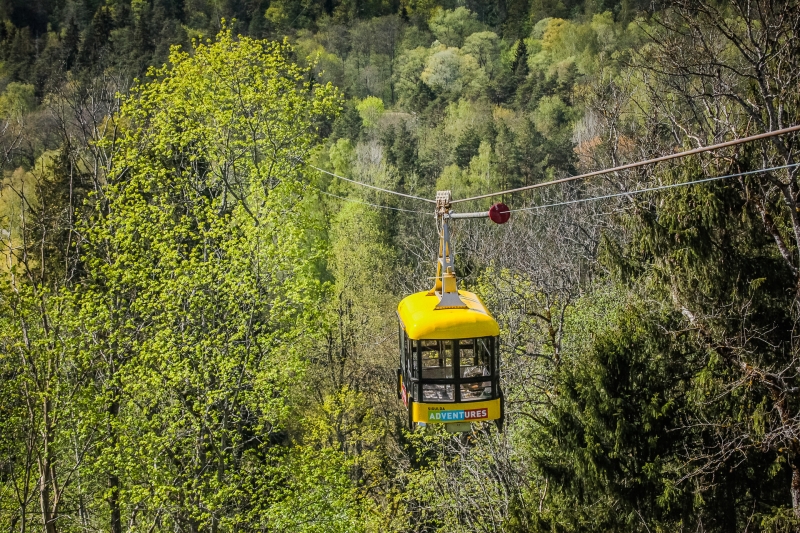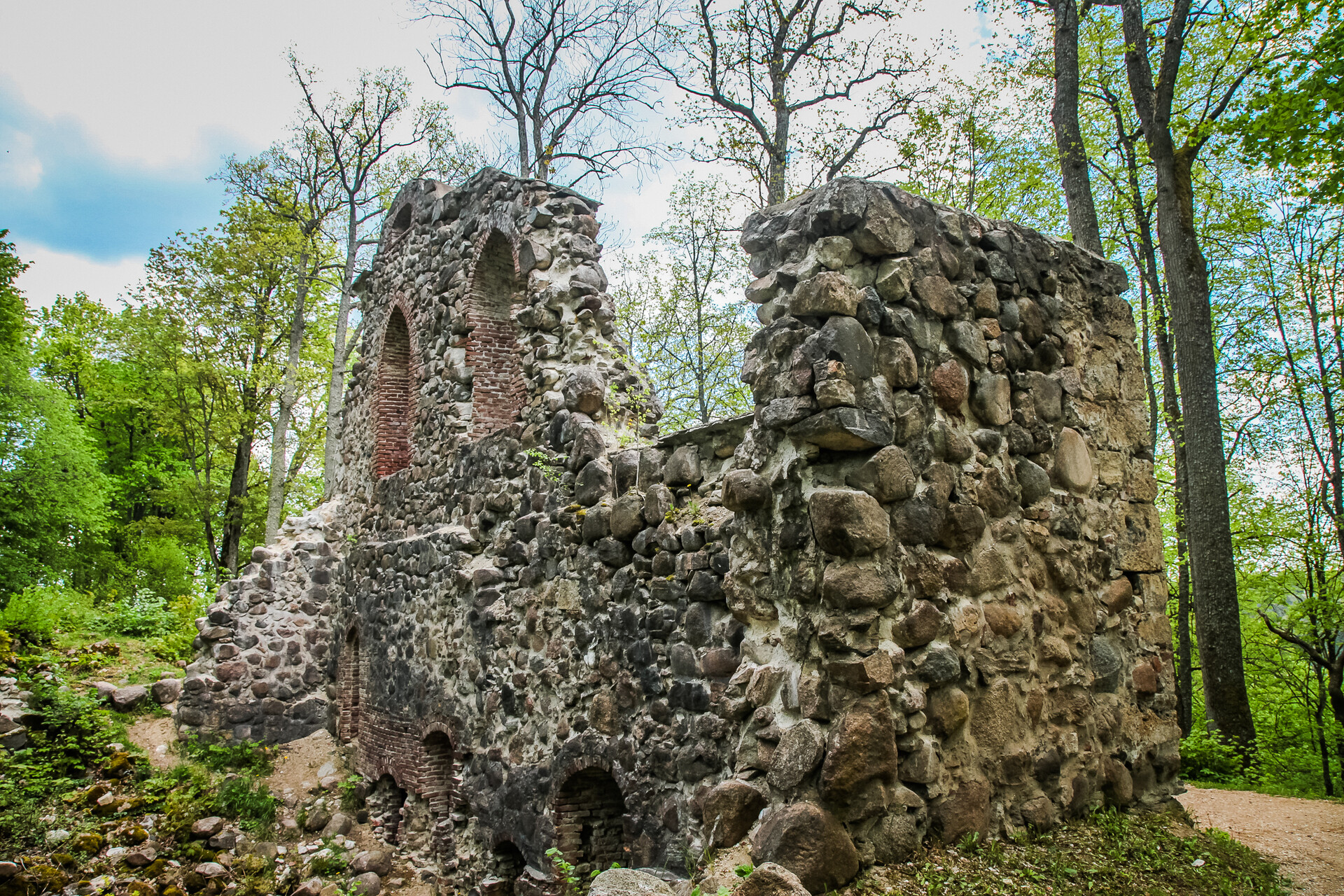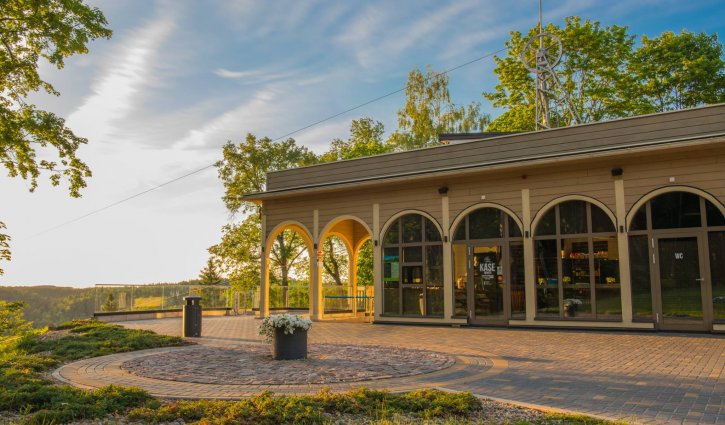
Sigulda cable car offers a trip over the Gauja old valley, overlooking a charming landscape of several kilometers, including Sigulda and Turaida castle, Krimulda manor house, as well as the Bobsleigh and luge track "Sigulda". The cable car connects both riverbanks in a width of 1025 meters.
This autumn, the symbol of the Sigulda Cable car has regained its new shape and look. The author of the new bear is a textile artist, Kristīne Kligina from Sigulda. The artist herself says about the implemented project and cooperation: “The bear is a symbol of strength and power, at the same time embodying both monstrous wildness and love. I am an artist and have been making bear figures for more than ten years. Over time, I have gone from very small children's toys to monumental sculptures of textile materials, even more than 2 m high. The little teddy bear has aroused my personal interest in the meaning of the bear's image."!
| Address |
Poruka iela 14, Sigulda Krimuldas iela 3, Sigulda |
| Coordinates | 57.1645 24.8458 |
| Phone | +371 28020088 |
| www | |
| Working hours (November) |
Monday 10.00 - 17.00 Tuesday 10.00 - 17.00 Wednesday 10.00 - 17.00 Thursday 10.00 - 17.00 Friday 10.00 - 17.00 Saturday 10.00 - 17.00 Sunday 12.00 - 17.00 |
The cable car history
The author of the idea about the cable car is Sigulda local Aivars Janelsītis. One evening, when the bridge over the Gauja after the war had not been restored yet, he sat on the left bank of the Gauja river - on the side of Sigulda - and thought that he, like a birdie, could cross over to Krimulda, where his beloved Genoveva worked as a nurse at the sanatorium. A few years later, when Aivars and Genoveva were already married, a magazine published an article on passenger cableways in the Georgian mountain town of Chiatura. Aivars Janelsītis, working as the head of the Community Management of Riga District Executive Committee from 1954 to 1974, began a correspondence with the author of the cableway G. Panceluja. A proposal for the construction of a cableway across the Gauja old valley was prepared for the district administration, support was requested at the republican level from the Cabinet of Ministers, a project was prepared, a Georgian delegation was admitted to the 750th anniversary of Sigulda, and Georgians announced that they would donate a technical project and equipment to Sigulda. However, the works in 1962 were stopped and resumed only in 1965. The cableway mechanism was made in Leningrad, Russia, and a cable car with a capacity of 22 people - at the Riga Wagon Factory. More than 200 people worked at it so that it would become a cableway. The technical project was elaborated on by 20 people.
At the beginning of 1969, with an orchestra playing, a 1025-meter long trail over the valley was unveiled. The bearing cable without middle support connects the banks of the Gauja River valley between Sigulda and Krimulda at a height of about 40 meters above the river. In the first year, 270 000 passengers were carried by the cable car, including locals and city guests. In the following years, the number of passengers of the cable car reached almost 300 000 people a year, becoming not only a symbol of Sigulda but also a very popular tourist destination. Estimates suggest that during the first 40 years of existence of the wagon, about 6 million people have traveled with it.
With a Cable car, you can travel from Sigulda to Krimulda. In Krimulda there are several tourist attractions that you can see:

Krimulda Medieval Castle
During the 13th century, the left bank of the Gauja river was governed by the Order of the Brethren of the Sword, (later known as the Order of Livonia), while the territories on the right bank were under the domain of the Archbishop of Riga. Krimulda castle belonged to the Riga High Council which was a group of twelve high priests who advised the archbishop.
Krimulda castle was built on the edge of a high bank on the right side of Gauja near the Vikmeste castle mound and the village of Livs. This placement made it nearly impossible to conquer. On one side it was protected by the steep valley wall of Gauja river, two additional sides were obstructed by the Vikmeste river, which had equally steep banks, and the fourth side bordered on a man-made ravine with a draw-bridge leading into the forecastle. The deep valley of the Vikmeste River also provided a natural borderline between the lands of Krimulda and Turaida.
Krimulda Manor
.jpg)
The residential house of Firsts Lievens was built in around 1822 in the style of classicism. The manor complex features the manager’s house, coach house, cattle yard, Swiss House, etc. For 95 years already, a rehabilitation institution, which offers accommodation services as well, has been operating at the manor. Tasting events of fruit and floral wines are offered to the guests of the manor by prior arrangement. The medieval castle is situated nearby.
Ancient manuscripts show that, by the 15th century, the area between Krimulda castle and the park ponds had become a town of craftsmen. The population continued to grow, overtaking that of both Sigulda and the opposite bank of Gauja until it became the established center of the region. This changed dramatically after the fire when only four people remained. Later documents mention only one inhabitant.
When the castles of the Livonian Order and the Archbishop of Riga were leased out in 1566, Krimulda manor became a self-sustaining feudal property.
The castle changed hands from one owner to another up until 1817 when it was purchased at auction by Prince Johan George Liven. The Prince, whose family claim they are descended from the Liv leader Kaupo, made the purchase based on his historical ties. He built a manor commensurate to the family status and also developed a romantic park in the area. The castle itself is a relatively small building with a cube-like central part. It is decorated by a massive porch supported by four columns and has symmetrical one-story wings on both sides. Undisputedly, it’s most notable attribute is its placement within the natural setting. Inhabitants and guests alike could enjoy the scenic view from the precipice terrace, the balcony, or the little tower.
For many years people thought the castle was built in the middle of the 19th century until art historian and castle researcher -Dainis Brugis - came to a different conclusion. Following a careful analysis of the facts and biographical information of the owners of Krimulda manor, he concluded that the manor had been built in 1822. This building is one of the most notable examples in Latvia of a classic villa.
Krimulda Serpentine road
Roads connecting Sigulda, Krimulda and Turaida have formed over the course of many centuries. One of these, Serpentine Road from Krimulda to Sigulda, is rich with history.
This road partially lies within the former moat of Krimulda Medieval castle and follows down the slope to Sigulda.
The idea for this road can be seen in the Krimulda castle and manor drawings from the 17th century. To provide safe travel for horse-drawn carriages up and down the Gauja valley, the road was made winding to reduce the grade. The word serpentine comes from the Latin word - serpent and means snake. It is commonly believed that the majority of improvements made to this road occurred just prior to the 1862 visit to Sigulda by Alexander II, Tzar of Russia, and his spouse. The tourist pathways were also improved at this time. Above the road were rope bridges which the locals referred to as devil's bridges.
With the development of the automobile and paved roads, the Serpentine road was no longer illuminated during the second part of the 20th century. In 2006 a historic reconstruction of the road was conducted, the road was cobbled and light posts and benches installed. The Serpentine road has now become a place for a romantic walk. It is also bicycle accessible.













